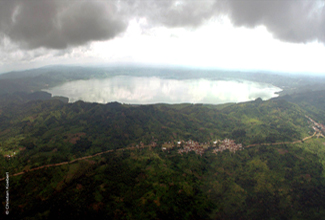Signs of life found in a million year old crater

At present, there are over 150 identified terrestrial craters originated by asteroid and comet impacts. These events can have profound effects on life, especially for microorganisms like bacteria and archaea, since the energy liberated during the impact can locally sterilize the soils due to the high temperatures and pressures induced. Moreover, habitat availability and characteristics for microorganisms living at the surface and subsurface can experience drastic changes. The consequences of impact events are scaled with the size of the impacting body, so that extremely powerful episodes, although rare, can induce not only local effects but reach the regional and global environment, by, for instance, generating dust clouds or acid rain.
The Bosumtwi impact structure in Ghana (west Africa) is a 10.5 km wide crater that was originated 1.07 millions of years ago and which currently encloses a 78 m deep lake. The Bosumtwi structure is of middle-size, since larger craters have been described, such as Vredefort (South-Africa) with a diameter of about 300 km. Within the GEPOC group (Grup d’Estudis de Processos Oceànics i del Clima), operating at ICTA (Institut de Ciència i Tecnologia Ambientals), we study among other indicators, the lipids of the archaeal membranes, since these molecules can give us some information on past temperatures and thus are useful for past climate reconstructions in several environments. In a collaboration with the University of Vienna, we investigated the archaeal lipids in the impacted rocks from the Bosumtwi structure. The lipid concentrations we measured were relatively low but the interesting part of the study was to attempt to interprete the origin of these lipids that were occurring in rocks buried at 300 m below the lake. In the article “Archaeabacterial lipids in drill core samples from the Bosumtwi impact structure, Ghana” we discussed three hypothesis: (i) these lipids are from soils and rocks pre-dating the impact event and have survived the high temperatures generated during the episode, (ii) these lipids were generated by high-temperature adapted archaea that proliferated in the postimpact hydrothermal system generated and (iii) the lipids are synthesized by much more recent archaea living in the lake, and the water percolating into the sediments and rocks under the lake transported the lipids to the depths were we found them.
References
Archaeabacterial lipids in drill core samples from the Bosumtwi impact structure, GhanA. Escala, M; Rosell-Mele, A; Fietz, S; Koeberl, C. METEORITICS & PLANETARY SCIENCE, 43 (11): 1777-1782 NOV 2008

